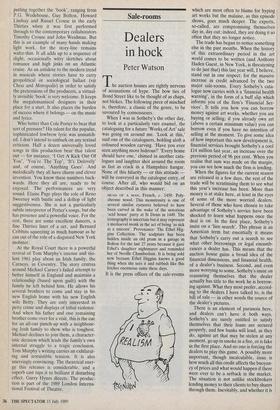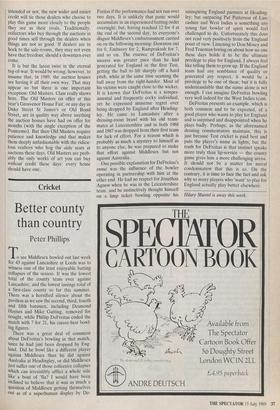Sale-rooms
Dealers in hock
Peter Watson
The auction houses are rightly nervous of accusations of hype. The bow ties of Bond Street like to be thought of as chaps, not blokes. The following piece of mischief is, therefore, a classic of the genre, to he savoured by connoisseurs.
When I was in Sotheby's the other day, to look at a particularly rare enamel, the cataloguing for a future 'Works of Art' sale was going on around me. 'Look at this,' said one of the cataloguers, holding aloft a coloured wooden carving. `Have you ever seen anything more hideous?' 'Every home should have one,' chimed in another cata: loguer and laughter shot around the room as fast as crack in a Hampshire hangar. None of this hilarity — or this attitude will be conveyed in the catalogue entry, of course. After all, who would bid on an object described in this manner: HEAD OF A MAN, French, C. 1450. Poly- chrome wood. This monstrosity is one of several similar eyesores believed to have been carved in the wake of the notorious `acid house' party at St Denis in 1449. The iconography is uncertain but it may represent a mediaeval monk in the act of being 'as sick as a unicorn'. Provenance: The Ethel Hig- gins Collection. The sculpture has been hidden inside an old pram in a garage in Bolton for the last 27 years because it gave Ethel's daughter nightmares' and reminded her of Neville Chamberlain. It is being sold now because Ethel Higgins knows a good thing when she sees it and rubbish like this fetches enormous sums these days.
It is the press offices of the sale-rooms which are most often to blame for hyping art works but the malaise, as this episode shows, goes much deeper. The experts, so-called, are compromising themselves day in, day out; indeed, they are doing it so often that they no longer notice.
The trade has begun to notice something else in the past months. When the history of this extraordinary period in the art world comes to be written (and Anthony Haden Guest, in New York, is threatening to do just that) this last year will, I believe, stand out in one respect: for the massive increase in credit advanced by the two major sale-rooms. Every Sotheby's cata- logue now carries with it a 'financial health warning', in the form of a buff slip which informs you of the firm's 'Financial Ser- vices'. It tells you how you can borrow money against art works, whether you are buying or selling; if you already own art (above a certain minimum valne) you can borrow even if you have no intention of selling at the moment. To give some idea of how important this new development is, financial services brought Sotheby's a cool i14 million last year, an increase over the previous period of 96 per cent. When you realise that sum was made on the margin, you can see how much the firm is lending.
When the figures for the current season are released in a few days, the rest of the trade will be scrutinising them to see what this year's increase has been. More than money is at stake here, at least in the eyes of some of the more worried dealers. Several of those who have chosen to take advantage of Sotheby's service have been shocked to learn what happens once the deal is on. In the first place, Sotheby's insist on a 'lien search'. This phrase is an American term but essentially it means that Sotheby's carry out a search to see what other borrowings or legal encumb- rances a dealer has. This means that the auction house gains a broad idea of the financial dimensions, and financial health, of a dealer's business. Second, and even more worrying to some, Sotheby's insist on reassuring themselves that the dealer actually has title to the work he is borrow: ing against. What they most prefer, accord- ing to the dealers I have talked to, is the bill of sale — in other words the source of the dealer's pictures.
There is an element of paranoia here, and dealers can't have it both ways. Sotheby's are surely entitled to satisfy themselves that their loans are secured properly, and few banks will lend, as they do, against art that may be stolen at any moment, go up in smoke in a fire, or is fake in the first place. And no one is forcing the dealers to play this game. A possibly more important, though incalculable, issue is how much all this credit affects the buoyan- cy of prices and what would happen if there were ever to be a setback in the market. The situation is not unlike stockbrokers lending money to their clients to buy shares through them. Inevitably, and whether it is intended or not, the new wider and easier credit will tie those dealers who choose to play this game more closely to the people they see as their rivals, Traditionally, collectors who buy through the auctions in good times sell through the dealers when things are not so good. If dealers are in hock to the sale-rooms, they may not even have that freedom, should a downturn ever come.
It is but the latest twist in the eternal tug-of-war. It would be wrong, however, to assume that, in 1989, the auction houses are having it all their own way. That may appear so but there is one important exception: Old Masters. Class really shows here. The Old Masters on offer at this year's Grosvenor House Fair, or any day in Duke Street St James's or Old Bond Street, are in quality way above anything the auction houses have had on offer for months (with the single exception of the Pontormo). But then Old Masters require patience and knowledge and that makes them deeply unfashionable with the ridicu- lous realtors who hog the aisle seats at auctions these days. Old Masters are prob- ably the only works of art you can buy without credit these days: every home should have one.



















































 Previous page
Previous page